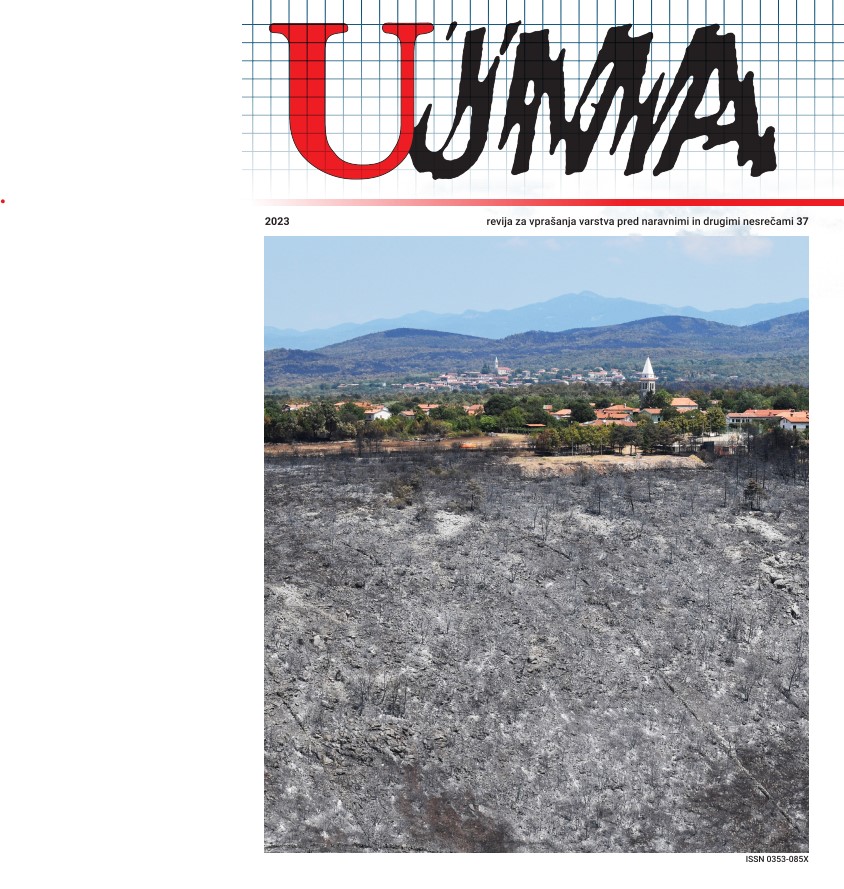KNOWLEDGE OF POISONOUS PLANTS AND FIRST AID
Abstract
In Slovenia, poisoning from plants accounts for a small proportion of all poisonings. In young people, poisoning often occurs due to the desired hallucinogenic effect, while in older people poisoning is more likely to be caused by mistaking poisonous plants for edible ones. In cases of poisoning by a poisonous plant, rapid first aid measures and immediate professional medical assistance are crucial. The aim of this study was to determine people’s familiarity with selected poisonous plants and their knowledge of first aid measures in the event of poisoning. Data were collected through a web survey using the 1KA application and a printed version of the questionnaire. A total of 301 people participated in the study. The respondents were best able to identify lily of the valley, common ivy, black elderberry, and yew in the provided photographs. The poisoning symptoms most commonly reported by respondents were vomiting, nausea, diarrhoea, abdominal pain, digestive problems, and dizziness. The respondents were aware that first aid measures for poisoning from poisonous plants were to clean the oral cavity, induce vomiting (after consulting a doctor), take activated charcoal (after consulting a doctor), and preserve remnants of the plant. Candidates should familiarise themselves with basic first aid procedures for poisoning from poisonous plants through various first aid courses, as this topic is often overlooked.
References
Avau, B., Borra, V., Vanhove, A. C., Vandekerckhove, P., De Paepe, P., & De Buck, E., 2018. First aid interventions by laypeople for acute oral poisoning. The Cochrane database of systematic reviews, 12(12), Art. No.: CD013230. https://doi.org/10.1002/14651858. CD013230, 22. 2. 2021.
Brvar, M., 2006. Zastrupitve. In U. Ahčan (Ed.), Prva pomoč: priročnik s praktičnimi primeri (pp. 154–175). Rdeči križ Slovenije.
Brvar, M., & Jamšek, M., 2014. Zastrupitve z rastlinami, ki so podobne čemažu. In M. Brvar (Ed.), Toksikologija 2014: Zastrupitve s strupenimi rastlinami (pp. 9–17). Slovensko zdravniško društvo – Sekcija za klinično toksikologijo.
Center za klinično toksikologijo in farmakologijo UKC Ljubljana, 2023. Prva pomoč pri zastrupitvah. http://ktf.si/prva-pomoc/, 20. 7. 2023.
Fatur, K., & Kreft, S., 2021. Nixing the nightshades: traditional knowledge of intoxicating members of the Solanaceae among hallucinogenic plant and mushroom users in Slovenia. Public library of science one, 16(2), e0247688. https://doi.org/10.1371/journal.pone.0247688, 22. 2. 2021.
Ghorani-Azam, A., Sepahi, S., Riahi-Zanjani, B., Alizadeh Ghamsari, A., Mohajeri, S. A., & Balali-Mood, M., 2018. Plant toxins and acute medicinal plant poisoning in children: a systematic literature review. Journal of research in medical sciences : the official journal of Isfahan University of Medical Sciences, 23(26). https://dx.doi.org/10.4103%2Fjrms.JRMS_629_17, 24. 8. 2023.
Grmec, Š., 2008. Zastupitve. In Š. Grmec (Ed), Nujna stanja (pp. 311–351). Zavod za razvoj družinske medicine.
IFRC (International Federation of Red Cross & Red Crescent Societies), 2020. International first aid, resuscitation, and education guidelines 2020. IFRC, Geneva.
Jogan, N., 2015. Prepoznavanje strupenih rastlin v Sloveniji. In M. Brvar (Ed.), Toksikologija 2014: Zastrupitve s strupenimi rastlinami (pp. 31–43). Slovensko zdravniško društvo – Sekcija za klinično toksikologijo.
Kharusha, I. K., Sulaiman, S. S., Samara, A. M., Al-Jabi, S. W., & Zyoud, S. H., 2020. Assessment of knowledge about first aid methods, diagnosis, and management of snakebite among nursing students: a cross-sectional study from Palestine. Emergency medicine international, 2020, 8815632. https://doi.org/10.1155/2020/8815632, 16. 12. 2020.
Ladinik, A., 2015. Prva pomoč ob zastrupitvah [diplomsko delo]. Univerza v Mariboru, Fakulteta za zdravstvene vede. https://dk.um.si/Dokument.php?id=82002&lang=slv, 24. 8. 2023.
Martínez Monseny, A., Martínez Sánchez, L., Margarit Soler, A., Trenchs Sainz de la Maza, V., & Luaces Cubells, C., 2015. Poisonous plants: an ongoing problem. Anales de pediatria, 82(5), 347–353. https://doi.org/10.1016/j.anpedi.2014.08.008, 24. 8. 2023.
Ng, W. Y., Hung, L. Y., Lam, Y. H., Chan, S. S., Pang, K. S., Chong, Y. K., Ching, C. K., & Mak, T., 2019. Poisoning by toxic plants in Hong Kong: a 15-year review. Hong Kong medical journal, 25(2), 102–112. https://doi.org/10.12809/hkmj187745, 10. 4. 2019.
Pogačar, E., in Malić, Ž., 2022. Priročnik za interno uporabo za Temeljni program usposabljanja članov in pripadnikov enot za prvo pomoč za bolničarja prve pomoči. Ljubljana: Rdeči križ Slovenije.
Slabe, D., 2016. Prva pomoč kot oblika solidarnosti v sodobni slovenski družbi [doktorska disertacija]. Univerza v Ljubljani, Fakulteta za družbene vede. http://dk.fdv.uni-lj.si/doktorska_dela/pdfs/dr_slabe-damjan.pdf, 23. 8. 2023.
Zellner, T., Prasa, D., Färber, E., Hoffmann-Walbeck, P., Genser, D., & Eyer, F., 2019. The use of activated charcoal to treat intoxications. Deutsches arzteblatt international, 116(18), 311–317. https://doi.org/10.3238/arztebl.2019.0311, 3. 5. 2019.
Downloads
Published
Issue
Section
License

This work is licensed under a Creative Commons Attribution-NonCommercial-NoDerivatives 4.0 International License.
The articles are made available to the public under Creative Commons Attribution-NonCommercial-NoDerivatives 4.0 International (CC BY-NC-ND 4.0).


